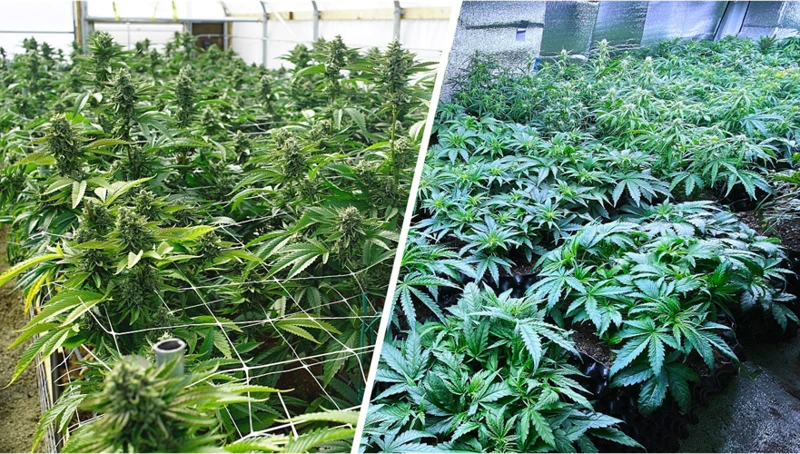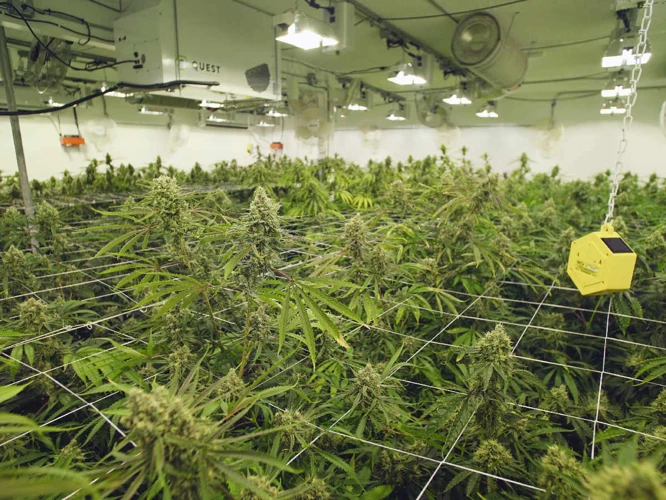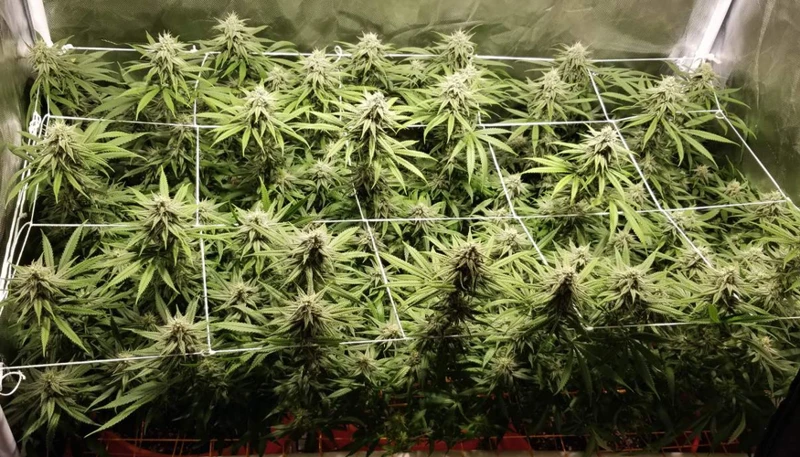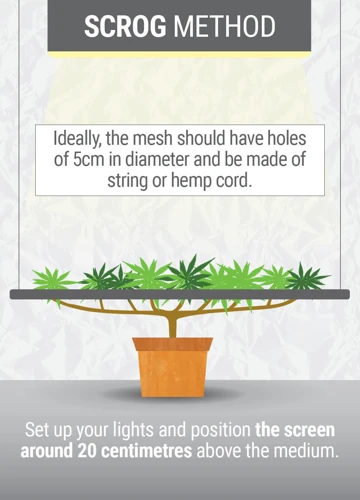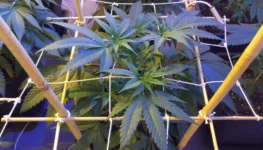
Maximizing Cannabis Yields with LST Techniques
Growing cannabis can be a fulfilling hobby or a profitable business venture. However, mastering the art of cannabis cultivation requires knowledge and technique. One such technique is Low Stress Training or LST, a method for manipulating plant growth to maximize yield and potency. New cultivators may be confused by the different LST techniques available, particularly for SOG and SCROG grow methods. Understanding the science behind LST and its pros and cons for each grow method can help growers choose the right approach. This article will explore LST for SOG and SCROG, how to apply LST techniques, maximizing LST efficiency, and common mistakes to avoid.
What is LST?
Contents
As a beginner grower, you may have come across the term LST and wondered what it means. LST, or Low Stress Training, is a popular technique used by cannabis growers to shape their plants and increase yields. It involves gently bending and manipulating the plant’s stem and branches to encourage it to grow horizontally instead of vertically. With strategic placement of the branches, growers can create an even canopy of buds that receives proper light and airflow. But how does LST work? Let’s dive deeper into the purpose and science behind LST.
The Purpose of LST
One of the primary purposes of LST or Low-Stress Training is to manipulate the growth pattern of cannabis plants. This technique helps growers create a flat, even canopy of buds, which results in bigger yields and more even distribution of light to all parts of the plant. Here are some other reasons why growers use LST:
- To Maximize Yield: LST techniques, especially when used in combination with other training methods, can help increase the size and number of buds a plant produces. This is because better access to light and air flow can promote more abundant flower development.
- To Control Plant Height: LST can also help control the height of plants. Instead of growing tall and leggy, plants trained with LST will become bushier and shorter, which makes them more manageable and easier to control. This is especially helpful for indoor growers with limited vertical space.
- To Increase Light Exposure: By manipulating the position of the plant’s branches, LST can help ensure that each bud site gets optimal light exposure. This results in bigger buds, increased potency, and more effective use of light.
- To Boost Airflow: When plants are trained with LST, the shape of the plant becomes more open and less dense, creating better airflow around the plants. Good airflow is important because it can help prevent mold and pests from infesting the plants.
LST is an effective tool that growers can use to shape their plants and maximize their yields while also promoting better airflow and light distribution. With proper technique and attention to detail, LST can produce impressive results that any cannabis grower would be proud of.
The Science of LST
LST or Low Stress Training is a growing technique that involves bending and tying down the branches of cannabis plants in order to redirect their growth. This technique is based on the science of plant biology and the principles of phototropism.
Phototropism is the ability of plants to adjust their growth in response to the direction and intensity of light. Cannabis plants naturally grow towards the light source, which in indoor grows is usually artificial lighting. This means that the top of the plant, where the main bud or cola will form, receives the most light and grows the fastest.
LST takes advantage of this natural tendency by manipulating the plant’s growth pattern to produce more buds at the same level as the main cola. By bending and tying down the side branches, LST spreads out the plant’s energy and creates multiple colas that receive the same amount of light.
Additionally, LST helps to create a more optimized canopy by reducing the height of the plant and evening out the tops of the colas. This can help to prevent hot spots or areas of the grow room that receive too much light, which can lead to heat stress and reduced yield.
The LST technique is also thought to stimulate the plant’s growth hormones and promote lateral branching. When the branches are tied down, the stress signals the plant to produce more auxins, a growth hormone that stimulates cell elongation and lateral bud growth. This results in stronger and bushier plants with more sites for bud formation.
The science of LST is rooted in the principles of plant biology and phototropism. By redirecting the plant’s growth and stimulating growth hormones, LST can be a highly effective technique for increasing yield and producing more buds for cannabis cultivators.
LST for SOG Grows
When it comes to maximizing the yield of your cannabis plants in a limited space, the Sea of Green (SOG) growing method is a go-to choice for many growers. However, traditional SOG techniques can result in uneven canopy growth and lower yields. This is where low stress training (LST) comes in as an effective solution. By utilizing LST techniques, SOG growers can promote horizontal growth and greater light exposure, resulting in healthier and more productive plants. Let’s take a closer look at the pros and cons of using LST for SOG grows.
Pros of LST for SOG
Pros of LST for SOG
LST, or Low-Stress Training, is a highly popular technique among cannabis growers, used for maximizing yields and enhancing plant growth. When it comes to SOG (Sea of Green) grows, LST is considered one of the most effective ways to manage an entire crop without needing individual plant training. Here are the advantages of using LST for SOG:
| Pros | Explanation |
|---|---|
| Increased Yields | With LST, cannabis growers can expose multiple bud sites to light, resulting in larger yields per plant. By bending the branches and stems downwards, growers can promote lateral growth and even canopy coverage, which encourages bud production. LST enables growers to train plants to grow horizontally, helping to produce more buds from a single plant rather than growing taller with only one dominant cola. |
| Better Light Penetration | With the use of LST techniques for SOG, cannabis growers can achieve deeper and more efficient light penetration, leading to bigger and better quality buds. By positioning the branches so that the entire plant is exposed to the light, growers can ensure that all bud sites are getting an equal amount of light. This is especially important in SOG grows because it maximizes the yield per square foot of space. |
| Improved Plant Health | LST causes less stress on plants than other training techniques, which reduces the chances of over-stressing and causing damage. This means growers can be more aggressive with LST methods without harming the plants. Additionally, LST increases the surface area for the foliage, allowing for better air-flow and exposure to nutrients for overall improved plant health. |
| Shorter Vegetative Stage | By training the plants through LST, growers can shorten the vegetative stage to suit their timer. This shortening of the vegetative stage is crucial for growers who want to take advantage of SOG’s shorter growth cycle, allowing them to harvest more frequently throughout the year. |
LST remains an effective technique for SOG growers. By using LST techniques, growers can increase yields, promote even-light coverage, mitigate growing damage, and significantly reduce the time of their vegetative stage, creating more harvest opportunities annually.
Cons of LST for SOG
While LST is a popular technique for SOG growing, it still has some limitations that growers should be aware of. Here are some cons of LST for SOG:
- Requires frequent maintenance: LST requires regular checking and adjustment of plant branches to ensure they are properly trained. This can be time-consuming and labor-intensive, particularly when growing in large quantities.
- Increases the risk of plant damage: The process of bending and manipulating branches can increase the risk of damaging the plant, particularly if done too aggressively or too early in the plant’s growth cycle. This can lead to stunted growth, reduced yields, or even the death of the plant.
- May not be suitable for all strains: Not all cannabis strains respond well to LST techniques. Some plants may not be able to withstand the stress of bending and manipulation, leading to poor performance or lower yields. It is important to carefully consider the specific needs of the strain before attempting LST.
- Can lead to uneven growth: While LST can help increase overall yield, it may also result in uneven growth patterns if not done properly. Uneven growth can make it difficult to control the canopy, leading to issues with light distribution and overall plant health.
It is important to weigh the benefits of LST against these cons before deciding to use this technique for SOG growing. With proper planning, attention to detail, and careful management, growers can successfully implement LST and achieve impressive results.
LST for SCROG Grows
As growers seek innovative methods to increase their yield, one popular technique is the Screen of Green (SCROG) grow. This involves training plants to grow horizontally, which can be achieved with the use of Low Stress Training (LST). LST for SCROG grows involves a different approach compared to its use in Sea of Green (SOG) grows. In this section, we will explore the benefits and drawbacks of LST for SCROG grows, as well as techniques on how to apply it effectively.
Pros of LST for SCROG
LST (low stress training) is a widely-used technique for optimizing the yield of cannabis plants. When it comes to SCROG (screen of green) growing methods, LST has several benefits that growers should consider:
- Increased yield: One of the primary benefits of LST for SCROG
grows is that it allows for better light penetration to lower growth sites. This helps to increase the size and number of buds, resulting in a higher yield come harvest time. - Improved bud quality: By using LST to spread out the canopy and create an even canopy, growers can ensure that all buds receive a similar amount of light. This can lead to larger, denser buds with higher THC content, improving the overall quality of the harvest.
- Better use of space: SCROG grows involve using a screen to create an even canopy. However, this can result in some parts of the plant being shaded and less productive. LST can help mitigate this issue by allowing growers to spread out the canopy and ensure all areas receive the necessary light to thrive.
- Reduced stress: Like with SOG grows, LST is a gentle approach to training cannabis plants. By avoiding high-stress techniques such as topping and pruning, growers can avoid causing undue stress to the plant, reducing the risk of stunting growth or causing damage.
- Cost-effective: Compared to other techniques such as topping and pruning, LST is a cost-effective way to increase yield and quality. It requires minimal investment in tools and equipment and is easy to learn and apply with a bit of practice.
LST is a versatile technique that can be used in a wide range of cannabis grows, including SCROG. By spreading out the canopy, reducing stress, and improving light penetration, LST can help growers achieve a bountiful harvest without sacrificing quality or causing harm to their plants.
Cons of LST for SCROG
Although LST can be effective for SCROG grows, there are some potential drawbacks that should be taken into consideration before implementing this technique. These include:
| Possibility of Overtraining | When applying LST to SCROG plants, it can be easy to get carried away and bend or train the plants too much. Overtraining can stress the plants and ultimately result in a decrease in yield. |
| Time-Consuming Process | LST for SCROG typically requires more time and effort than other growing methods due to the need for consistent monitoring and training of the plants. |
| Increased Risk of Infection | When training the plants, the leaves and stems can come into contact with soil or other plant material, which can increase the risk of infection and reduce the overall health of the plants. |
It is important to consider these potential drawbacks before deciding to implement LST for SCROG grows. However, with proper care and attention, LST can still be a highly effective method for maximizing yields and achieving desirable plant shapes.
How to Apply LST Techniques
Now that we understand the basics of LST, it’s time to learn how to apply these techniques to our SOG and SCROG growing methods. Applying LST properly can be the key to a successful cannabis harvest. But before we get started, let’s first make sure we have the right tools and materials on hand. By preparing our setup beforehand, we can ensure a smooth LST process and achieve the best results possible. So, let’s dive in and discover what we need and how to do it!
Tools Required for LST
To apply LST techniques effectively, there are some tools that are required for the process. Here are the necessary tools for LST:
- Soft Plant Ties: These ties are used to secure plants to their new position without causing damage or cuts. They are usually made of soft materials like rubber or plastic and have adjustable lengths to cater to different plant sizes.
- Bendable Wire: Bendable wires are useful for shaping and supporting the plants as they grow along the LST pattern. They should be flexible and sturdy enough to hold the weight of the plants.
- Scissors: A good pair of scissors is essential for pruning and cutting the plants during the LST process. They should be sharp and sanitized to prevent infections or diseases.
- Gloves: Gloves provide protection for your hands from the plant’s sticky residue and any harmful substances that may be present in fertilizers, soil, or pesticides used during the growing process.
By having these tools ready, you will be able to conduct the LST process effectively and minimize any damage or harm to the plants.
Step-by-Step Process for LST in SOG and SCROG
Step-by-Step Process for LST in SOG and SCROG
In order to successfully apply LST techniques for either SOG or SCROG grows, it’s important to follow a step-by-step process. Here are the steps to follow:
- Choose the right plants: When selecting plants for LST, it’s important to choose those that are vigorous and have strong branches. Weak branches will not be able to handle the stress of bending and tying.
- Identify the main stem: Determine which stem is the main stem and choose the branches that will become secondary stems. These should be evenly spaced around the main stem.
- Begin bending and tying: Start by gently bending the chosen branches down and away from the main stem. Use your fingers to apply gentle pressure to the stem until it’s bent at a 90-degree angle. Then, tie the branch down using a soft-tie or plant wire. Repeat this process with all selected branches.
- Monitor growth: As the plant grows, continue bending and tying the branches down as necessary. Make sure not to tie the branches too tightly or they may break.
- Remove extra growth: Any growth that forms below the canopy should be removed in order to direct all energy to the main and secondary stems. This will ensure that the plant produces a higher yield and doesn’t waste energy on unnecessary growth.
- Continue training: Continue to prune and train the plant until it reaches the desired shape and size. This will vary depending on the growing method being used (SOG or SCROG).
- Adjust ties: As the plant grows, it’s important to check the ties and adjust them as necessary. Make sure they are not too tight or too loose and that they are not damaging the plant.
- Patience is key: LST is a slow process that requires patience and attention to detail. Don’t rush the process and avoid making drastic changes to the plant all at once.
By following these steps, you can successfully implement LST techniques in both SOG and SCROG grows, resulting in higher yields and a more efficient use of space.
Maximizing LST Efficiency
When implementing Low-Stress Training (LST) techniques, maximizing efficiency is crucial to achieving the desired results. There are various factors that can affect the success of LST, including strain selection, timing, and duration. In this section, we will explore ways to optimize LST efficiency by examining the best cannabis strains for LST, determining the optimal timing and duration, avoiding common mistakes, and trying alternative techniques. Let’s dive in and discover how we can elevate our LST game.
Best Cannabis Strains for LST
When it comes to choosing the best cannabis strains for LST gardening, there are a few things to keep in mind. Firstly, you’ll want to select strains that are naturally flexible and pliable, as these strains will be easier to train and bend into the desired shape. Secondly, strains that grow bushy and have many side branches are ideal for LST, as these strains have the potential to produce multiple colas and maximize yield. Below are some cannabis strains that are known for their LST-friendly characteristics:
- Green Crack: This strain is highly flexible, making it perfect for LST techniques. It also produces a high yield with multiple colas, making it a favorite among growers.
- Sour Diesel: Sour Diesel is also a highly flexible strain that responds well to stress and can easily be bent into an LST shape. It produces a high yield and has a potent aroma that many cannabis enthusiasts enjoy.
- OG Kush: OG Kush is a popular strain that has bushy growth and many side branches, making it ideal for LST. It also produces a high yield and has a strong, relaxing effect.
- Blue Dream: Blue Dream is a sativa-dominant hybrid that grows tall and produces multiple side branches. It responds well to stress and can be easily trained into an LST shape. It also has a high yield and is known for its uplifting, creative effects.
- Girl Scout Cookies: Girl Scout Cookies is a balanced hybrid with a bushy growth pattern and multiple side branches. It responds well to stress and can be easily trained into an LST shape. It also produces a high yield and has a sweet, earthy aroma.
It’s important to note that while these strains are known for their LST-friendly characteristics, any cannabis strain can be trained using LST techniques. It all comes down to the grower’s patience and ability to train their plants into the desired shape. However, these strains may make the process a bit easier for those new to LST gardening.
Optimal LST Timing and Duration
When it comes to LST, timing and duration are essential factors. Optimal timing and duration can greatly affect the final result of your cannabis plants. It is crucial to start LST techniques at the right time and to maintain them for the ideal duration to get the most out of your plants.
The best time to start LST techniques is during the vegetative stage. The plant should have 3-5 nodes and be at least 2-3 weeks old. At this stage, the plant is still young and flexible, making it easier to manipulate. Waiting too long to start LST can result in stiff branches that can break or snap under pressure.
The duration of LST techniques varies depending on the desired outcome and the type of grow. In general, LST should be continued until the branches have filled out the available space and have reached the desired height. For SOG grows, this may be as short as 1-2 weeks, while for SCROG grows, it may take up to 4-5 weeks.
It is important to monitor the plant’s growth during LST and adjust the techniques as necessary. Be sure not to overdo it, as this can cause excessive stress on the plant and result in stunted or damaged growth. On the other hand, underutilizing LST can lead to underdeveloped plants that do not maximize their yield potential.
Here’s a summary of the optimal timing and duration for LST techniques:
| GROW TYPE | OPTIMAL LST TIMING | OPTIMAL LST DURATION |
|---|---|---|
| SOG | 2-3 weeks into vegetative stage | 1-2 weeks |
| SCROG | 2-4 weeks into vegetative stage | 4-5 weeks |
By timing and maintaining LST techniques properly, you can effectively control the shape and growth of your cannabis plants, resulting in a bountiful and successful harvest.
Common LST Mistakes and How to Avoid Them
Avoiding common LST mistakes is essential to achieve optimum results. Here are some of the most common LST mistakes and how to avoid them:
- Over-bending: It is important not to over-bend the plant stem during the LST process as it may cause permanent damage to the stem, thereby inhibiting growth. This is especially true for young plants with weaker stems. To avoid this mistake, ensure that you gently bend the stem and stop once you feel resistance.
- Under-bending: On the other hand, under-bending may lead to insufficient light exposure and restricted growth. To avoid this, make sure you bend the stem enough to allow for more light exposure without causing permanent damage.
- Not securing the branches: If you do not secure the bent branches with adequate support, they may spring back into an upright position, undoing the LST progress. To avoid this mistake, make use of ties, wires or clips to hold the branches in place.
- LST during flowering: LST during flowering can cause a lot of stress to the plants, which can cause stunted growth or even hermaphroditism. To avoid this mistake, LST should be done during the vegetative stage, at least two weeks before flowering.
- Overcrowding: Overcrowding the plants can lead to less light exposure and air circulation, which can impact growth negatively. To avoid this mistake, give your plants ample space to grow and do not overcrowd them.
- Over-trimming: Trimming excess foliage during LST can help improve light exposure, but over-trimming can cause the plant to lose too many valuable leaves, which are essential for photosynthesis. To avoid this mistake, remove only the necessary leaves and avoid overdoing it.
By avoiding these common LST mistakes, you can optimize your plant growth and increase your yield.
Alternative LST Techniques to Try
There are several alternative LST techniques that growers can experiment with to find the most effective method for their specific grow.
One such technique is super cropping, which involves gently pinching and bending the stem at strategic points to promote lateral growth and canopy development. This can be done by hand or with the use of pliers, and should be done during the vegetative phase.
Another technique is mainlining, also known as “manifolding”, which involves completely removing the plant’s main stem and training the two resulting stems to grow evenly and symmetrically. This can be done by cutting the main stem just above the second set of nodes and using LST to train the resulting stems.
Additionally, topping and fimming are commonly used LST techniques that involve removing the top of the plant’s main stem or its newest growth tips, respectively. This promotes even growth and prevents the plant from becoming too tall and spindly.
| Technique | Description |
|---|---|
| Super cropping | Gently pinching and bending stem for lateral growth |
| Mainlining | Removing main stem and training two resulting stems |
| Topping | Removing top of main stem for even growth |
| Fimming | Removing newest growth tips for even growth |
It’s important for growers to research and experiment with these techniques to find the best fit for their specific grow system and strains. However, it’s important to note that these techniques can stress the plant and should be done with care and attention to the plant’s needs.
Conclusion
In conclusion, it is evident that LST (Low Stress Training) is a highly effective technique for enhancing the growth and yield of cannabis plants. The efficiency of LST can be further maximized by selecting the right strains for cultivation, timing, and duration of training, and avoiding common mistakes in application.
By understanding the underlying purpose and science of LST, growers can gain greater control over their crops and achieve their desired results. This technique offers numerous benefits, including improved light penetration, increased bud sites, and overall plant health.
While LST can be applied to both SOG (Sea of Green) and SCROG (Screen of Green) growing methods, each approach has its own set of pros and cons that growers should consider. By carefully evaluating these factors, growers can determine which approach best aligns with their goals and resources.
To successfully apply LST techniques, growers need access to specific tools, such as soft ties, stakes, and screens. Furthermore, a step-by-step process must be followed to achieve the desired results.
It is important to note that different cannabis strains respond differently to LST, so growers should choose strains that are more flexible and with enough space to work with. Additionally, optimal timing and duration must also be considered in the LST process.
In conclusion, LST is a powerful tool that can help cannabis growers achieve greater yields and overall plant health. By carefully applying this technique, growers can maximize their efficiency and gain a competitive edge in the industry.
Frequently Asked Questions
What is the difference between SOG and SCROG growing methods?
SOG stands for Sea of Green, which involves growing many small cannabis plants in a confined space. SCROG, on the other hand, stands for Screen of Green, and involves training fewer plants to grow horizontally using a screen.
How does LST benefit SOG growing?
LST allows growers to control the height and shape of their plants, which can be beneficial in SOG grows where multiple plants are grown close together. LST can also increase potential yields by allowing for more even light distribution.
How does LST benefit SCROG growing?
LST is particularly useful in SCROG grows as it allows growers to train their plants to grow horizontally and fill out the screen evenly. This can result in a more even canopy and greater yields.
What tools do I need to apply LST techniques?
To apply LST techniques, you may need soft plant ties, bamboo stakes or other supports, and scissors or pruning shears for trimming and shaping the plant.
When is the best time to start LST?
The best time to start LST is during the vegetative stage when the plant is young and flexible. It is important not to start too early or too late as this can affect the effectiveness and success of the technique.
How long should I continue LST for?
The duration of LST will vary depending on the plant and the desired outcome. However, LST should typically be continued until the desired shape and canopy is achieved.
What are the most common mistakes to avoid when doing LST?
Common mistakes to avoid when doing LST include training the plant too aggressively, causing damage or stress to the plant, starting LST too late, and not checking the plant regularly to ensure it is growing and responding well to the technique.
What strains are best for LST?
Strains that are more flexible and have a tendency to grow tall and thin are generally better suited for LST. Some popular strains for LST include Green Crack, Sour Diesel, and Blue Dream.
What are some alternative LST techniques to try?
Some alternative LST techniques include tying the plant down to the sides of the container, using a trellis net to train the plant to grow horizontally, and using low-stress methods like FIM and topping to control plant height.
Can I use LST for plants other than cannabis?
Yes, LST can be applied to other plants such as tomatoes, peppers, and cucumbers to increase yields and improve plant structure.

